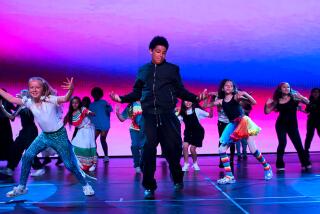Lubovitch Sees Ballet and Modern Dance Coming Closer Together
- Share via
SAN DIEGO — “The once heavily drawn lines between ballet and modern dance are fading. The rebellion against classical dance has played itself out, and things have to move on.”
So says Lar Lubovitch, the celebrated iconoclast whose artistic vision has catapulted the Lar Lubovitch Dance Company to the very top of the modern-dance heap. Nevertheless, when asked about balletic influences in his own cutting-edge choreographic style, Lubovitch turns defensive.
“I’ve been accused of that,” he said in a telephone interview from New York, “and when people say that they usually mean it in a negative way. There’s more fusion in my work now, but I just respond to movement. I don’t worry about the style. I use whatever I need.”
By his own admission, Lubovitch’s choreography is music-based. “That has been my raison d’etre.”
However, in his latest work-in-progress, “which hasn’t found its direction yet,” the unpredictable choreographer chose to eschew music entirely. How does he explain the obvious paradox?
“I’m trying to work out to my own satisfaction why dance is so dependent on music, visuals, and costumes. We see artists commissioning scores and working with other elements,” Lubovitch said. “But, when you take all that away, what’s left? A dance should be about movement.”
Although Lubovitch’s vivacious movement style revels in full-throttled physicality, the inventive dance maker shuns labeling a dance as a “pure movement” piece.
“I question whether there is such a thing,” he said. “No matter how abstracted the movements, there’s still human beings there. My movement is very ‘physicalized’ and very primal--full of guts and passion. And I look for those qualities when I choose my dancers.”
Lubovitch limits the size of his company to 14 dancers because “big companies are prohibitive for touring, and we do a lot of that.” But his crackerjack
dancers areamong the cream of the crop. In 1986, both the New York Times and the New York Post tagged his troupe as the best dance company of the year.
He himself has chalked up honors on several dance fronts, from the ice rink to the Great White Way.
Lubovitch designed ice dances for Olympic gold medalists John Curry, Dorothy Hamill and Peggy Fleming. He was nominated for a Tony for his choreographic contributions to the Broadway production of the Steven Sondheim musical “Into the Woods”--the fairy tale-based show that had its genesis in an Old Globe production.
“I wasn’t involved with the show in San Diego,” Lubovitch said. “It was completely restaged for Broadway with new scenery and costumes, and they needed movement. It’s still not a dance show, but I added stylized movement and helped the characters express themselves in movement.”
But don’t expect to see Lubovitch back on Broadway very often. His heart belongs to serious concert dance. He found the theatrical experience “a satisfying opportunity to apply my craft to another direction. And working with Stephen Sondheim and James Lapine is as high as it gets.”
This weekend, Lubovitch will return to San Diego, under the auspices of the San Diego Foundation for the Performing Arts. His two concert series at Symphony Hall, Friday and Saturday evening will launch an adventuresome season for the foundation that extends beyond traditional dance to include such contemporary works as Philip Glass’ “1000 Airplanes on the Roof” and Trisha Brown’s multimedia “Newark.”
The Lar Lubovitch Dance Company will perform a three-piece program that features “Musette,” set to Francis Poulenc’s “Concerto for Two Pianos,” the swirling patterns of “A Brahms Symphony” and “Concerto Six TwentyTwo,” a highly acclaimed dance work propelled by “Mozart’s Concerto for Clarinet and Orchestra,” K.622.
Lubovitch calls the program “very classical--at least musically”--and agrees that one of the highlights is the mercurial male duet in “Concerto Six TwentyTwo,” which ex-Martha Graham star Tim Wengerd singled out as “a dance you could die for” during his recent residency in town.
Although this dynamic duo is decidedly upbeat, Lubovitch says it was inspired by the AIDS epidemic.
“Yes, it’s a response to AIDS, but this is about friendship and dignity,” he said. “Artists have a moral imperative to respond to critical problems, but there are many ways to respond to it. The question is to respond.”
Unlike Wengerd’s heart-wrenching reaction to the disease, Lubovitch was moved to examine the underpinnings of male friendship because, “I thought it would be more useful to show the dignity of men in crisis than to show the agony. I did this duet because I feel that friendship is the highest level at which two men relate.”
Although other dance troupes struggle to survive, the 20-year-old Lar Lubovitch Dance Company continues to reach new heights. As Lubovitch tells it, “my company is very healthy.”
But what about the new generation of dance makers. Are there any talented gurus on the horizon?
“It’s difficult to know,” Lubovitch said. “There’s no one specific to point to. Some people in the contemporary-dance world flash very brightly, and people can be seduced by what they see. But will they pass the test of time?”
Lubovitch is dedicated to his company and his craft, but passing the torch to the next generation of choreographers is not one of his priorities.
“I’m not interested in teaching,” he said, revealing a hint of impatience in his voice. “I just do my work.”
Lubovitch’s amalgamation of ballet and modern movement attracted the attention of an arts foundation board member and was deemed the perfect choice to usher in a season of artistic crossovers.
More to Read
The biggest entertainment stories
Get our big stories about Hollywood, film, television, music, arts, culture and more right in your inbox as soon as they publish.
You may occasionally receive promotional content from the Los Angeles Times.










